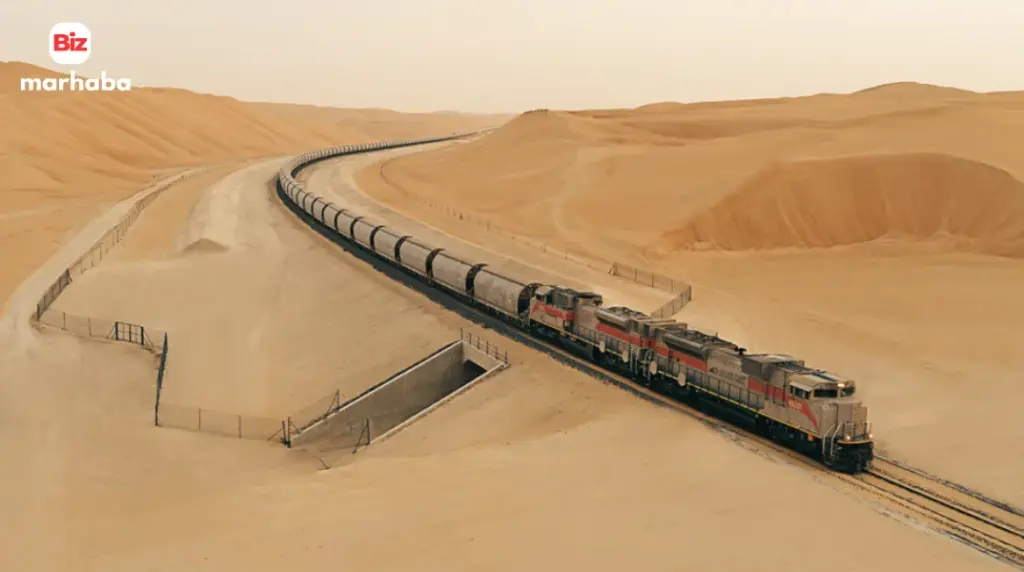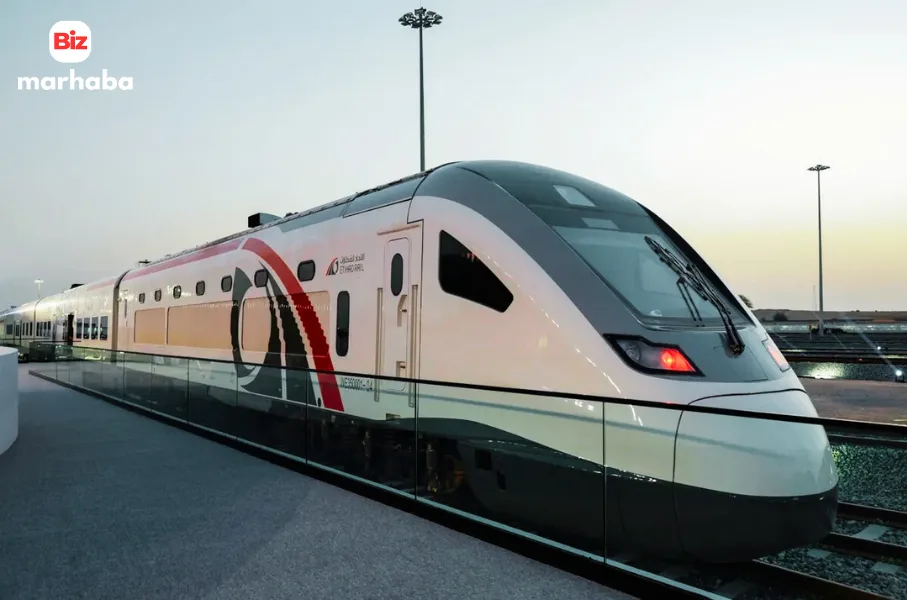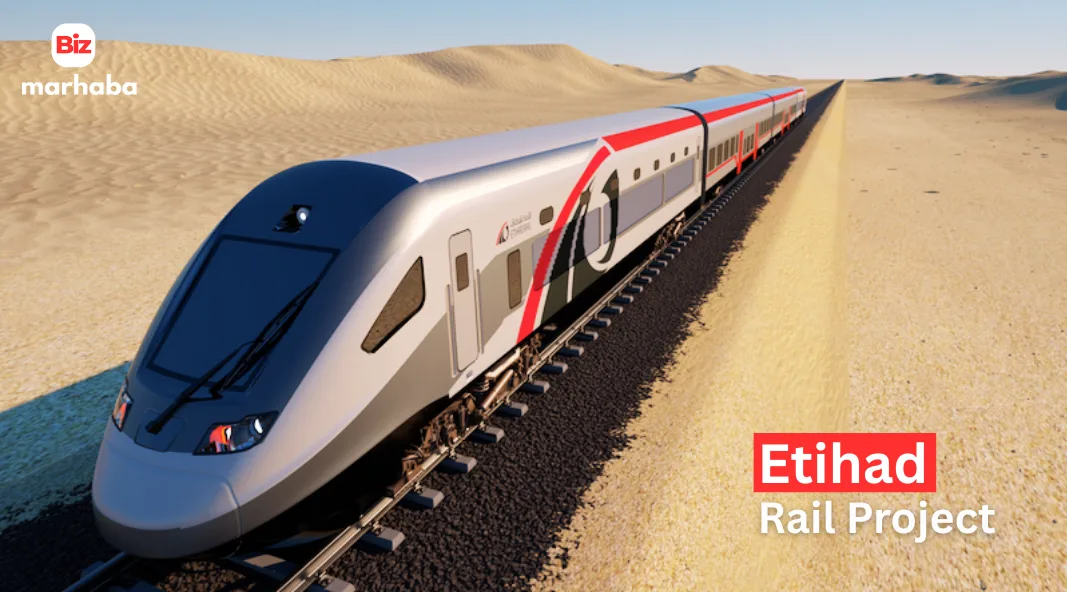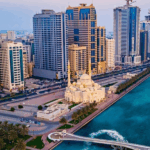- National Rail Network Progress
- High-Speed Dubai to Abu Dhabi Train Plans
- Passenger Stations and Ridership Goals
- Engineering and Civil Works
- Testing and Safety Inspections
- Economic and Environmental Impact
- Systems Integration and Staff Training
- Local Transport Connectivity
- Construction Challenges Across Emirates
- Road Closures and Relocations
- Certification and Delivery Milestones
- Passenger Service Timeline
- Future High-Speed Corridor
- FAQs
Etihad Rail work has accelerated as the UAE prepares to open passenger services in 2026. The Etihad Rail project will move from freight-only operations to full passenger service next year. Sheikh Mohammed bin Rashid Al Maktoum and other senior officials took a high-profile inspection and ride between Dubai and Fujairah in early August. The trip underlined the scale of the programme and the urgency of finishing the remaining civil works.
National Rail Network Progress
Construction teams say the national network now spans 900 kilometres and links the seven emirates from Ghuwaifat to Fujairah. Freight trains have run since Stage One began in 2016, and expanded freight operations across all emirates started after the Stage Two inauguration in February 2023 (Etihad Rail official statement). Work now focuses on stations, systems integration, signalling and last-mile connections. Local authorities have scheduled night closures and temporary diversions to speed those tasks, affecting roads such as Emirates Road this month.
High-Speed Dubai to Abu Dhabi Train Plans
Etihad Rail has also set out a complementary high-speed plan that would carry a high-speed Abu Dhabi–Dubai service at far higher velocities. Officials say the high-speed line would slash travel time to about 30 minutes between the two cities. That corridor is separate from the 200 km/h passenger trains that will run on the national network. Contracts and design work for the high-speed line are advancing, but civil works have not started.
Passenger Stations and Ridership Goals
Project managers say initial stations will be Abu Dhabi, Dubai, Sharjah and Fujairah. Each standard passenger train will carry about 400 people and run at up to 200 km/h. The operator expects the line to serve more than 36 million passengers a year by 2030. Integration with local transport — metros, buses and ticketing systems — is part of the plan to ensure seamless journeys and reduce car dependency.
Engineering and Civil Works

Engineers have completed many of the major structural packages but still face demanding tasks. Mountain tunnels through the Hajar range require specialist blasting and lining. Bridges and dozens of underpasses need final surfacing and safety inspections. Hitachi Rail STS and other contractors have been named for systems and signalling work on the wider network. The Etihad Rail project has prioritised integration and testing.
Testing and Safety Inspections
Public communications emphasise safety, testing and staged handovers. Trial runs with officials and regulators have accelerated after the August inspection ride. Authorities say these runs stress-test timetables, station operations and passenger interfaces.
Economic and Environmental Impact
The programme has drawn attention for its economic effects. Analysts and local media expect the Etihad Rail project to boost economic activity and interest in areas near stations and logistics hubs. Transport planners argue the network will cut truck movements and lower emissions. Etihad Rail leaders point to long-term benefits including cost savings on road repairs and improved freight efficiency.
Systems Integration and Staff Training
Systems and staff work now demands much of the project’s schedule. Officials say systems testing occupies many teams’ attention. Safety authorities and rail inspectors run daily checks. Staff train on ticketing, station and onboard services. Suppliers are delivering signalling racks and passenger information systems. Hitachi Rail STS holds a major systems contract for integration across the network.
Local Transport Connectivity
Local transport agencies have signed interoperability agreements with the rail operator. Dubai’s Roads and Transport Authority confirmed nol card usage on Etihad Rail, allowing single-ticket journeys across metro, bus and rail. The move reduces friction for commuters and speeds station throughput. Integration deals also include bus links and taxi interchanges at planned stations.
Construction Challenges Across Emirates

Contractors report active civil works on tunnels, bridges and station platforms. Teams are working on 35 bridges and dozens of underpasses through complex terrain, including the Al Hajar Mountains. These sections require careful sequencing to protect existing road networks. Authorities published temporary closures and diversions on key corridors to keep sites safe.
Road Closures and Relocations
Small but visible disruptions have accompanied the work. Road closures and lane diversions have appeared in several emirates. Local traffic authorities publish notices and temporary detours for drivers. Officials say these measures will shorten the final construction window and reduce risks during complex builds.
Utilities and municipalities coordinate to relocate services ahead of station openings. Power, communications and water lines must move in many places. Relocations add schedule risk but also make way for station landscaping.
Certification and Delivery Milestones
Work continues across the emirates every single day. Delivery risks remain. The Etihad Rail project now depends on clear certification milestones. Complex civil works, cross-emirate coordination and supply-chain delays can shift schedules. But the public milestones this year — visible test runs and VIP inspections — have trimmed uncertainty. Teams now concentrate on certification, staff training and finalising interoperability with local transit networks.
Passenger Service Timeline
Public appetite for clarity has grown as stations and timetables draw closer. Residents and businesses repeatedly ask, ‘When will Etihad Rail open for passengers?’ Authorities globally and in local media point to a 2026 commercial launch for passenger services. Officials say they will publish precise launch dates only after final regulatory approvals.
Future High-Speed Corridor
On the high-speed front, planners point to a distinct corridor for a high-speed Abu Dhabi–Dubai service. That Dubai to Abu Dhabi train proposal will require new track geometry and specialised rolling stock. Officials say preliminary designs and route options are under study and procurement will follow.
FAQs
Q: When will Etihad Rail open for passengers?
A: The operator has announced that passenger services will begin in 2026, with stations in major emirates opening in phases.
Q: Will the Dubai to Abu Dhabi train be a separate service?
A: Yes. Officials say the high-speed Dubai to Abu Dhabi train will be a distinct project from the national network. It will have a dedicated alignment, its own stations and specialised rolling stock.
Q: How long is the network and what services run now?
A: The national network covers around 900 kilometres and currently carries freight. Commercial freight operations began on the original Stage One in 2016 and expanded across the country after Stage Two completed in 2023.








